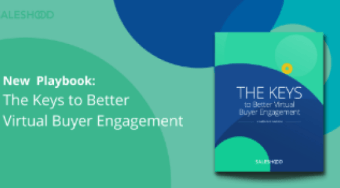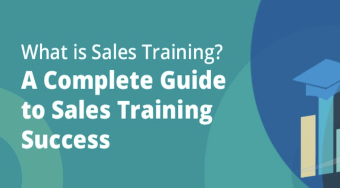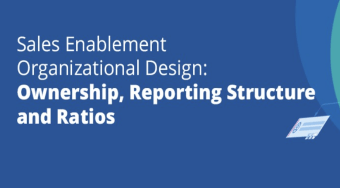Sales enablement content is critical to your organizations sales enablement efforts.
If the Apollo 11 astronauts were salespeople, their Sales Enablement team would have been the team back in Houston enabling them to succeed in their mission.
One of the sales team’s crucial tasks is to tell a story. In order to enable the sales team to believe in their message, be passionate about their job and put in their all, Sales Enablement needs to make them heroes of the story – and give them the right tools to complete their “quests”.
You wouldn’t send a knight to fight a dragon with a boring powerpoint presentation, would you? In order for Sales Enablement to truly empower, they need to provide their salespeople with the right content – a wide variety of creative tools they can use at the right time with any client.
This type of content has two purposes: the first one is obvious – to be effective with the client, to get them excited, informed, and to convince them that you’re going to provide solutions for them.
The second purpose of sales content is to empower the sales team: to make them feel proud, informed, excited, and inspired by what they do. In order for salespeople to perform their best, they need to truly believe that they are providing valuable solutions.
Content is the most powerful tool that Sales Enablement can provide a sales team. It’s also important that it’s searchable and well-organized. A great sales content library has to be like a professional kitchen – where every tool is easy to reach, intuitive, and exactly where you want it at the most crucial and often time-sensitive moments. Sales professionals have to be able to search by segment, industry, buyer, geography, and product in order to make their sales pitches as personalized and informed as possible.
Here are the most impactful and essential types of content that you can create and put in your sales team’s arsenal for an immediate impact:
External and Internal Types of Content
Sales content should be divided into two types: external and internal. It’s important to flag these types of content so the sales team can see it’s purpose at a glance.
What’s the difference between these two types of content?
Internal Content
Internal content has to be an informative piece of content that directly relates to your products – something like a price list, or a solid list of services. This is a must for sales people, and it has to be easy to categorise and distribute at a click of a button.
Perfect internal content has to be effortless to use, visual and intuitive. It’s the most important piece of content that you don’t want your sales team to ever have to struggle with.
External Content
External content is something outside of your own content pool. It can be an offsite blog, a video, a mention in a podcast or an interview. Maybe you can showcase your effectiveness by using specific content from the news, external blogs, or any type of outside mentions or market studies.
This type of content cannot be seen as trying to sell the product – rather, be informative, relevant and relatable. It’s best to use outside credible sources to support your brand’s story and authority. In order to build great external content you can:
- Reach out to industry leaders for third party mentions
- Use platforms like Quora to engage people and provide educational materials
- Be active on HARO and other places where you can provide journalists and bloggers with valuable industry knowledge – and be credited for it
Your salespeople should have external content at their fingertips, ready for show and tell.
Competitor Research and Analysis
What would we be without a little competition? First of all, we need to understand that competition isn’t bad – they drive us to do better. With that said, it’s always worth it to show the sales team what the competition is doing.
Competitor research shows the client:
- Areas where their competitors are driving the most sales
- How the competition is effectively connecting with their target audience
- What areas the client is leading in
A simple competitor analysis chart gives the salesperson a perfect at-a-glance plan of attack. They know exactly how to position their pitch, and what areas to concentrate on.
Most importantly of all, competitor research and analysis materials build confidence in the sales team. Confidence and knowledge make them more persuasive and authentic.
An effective way to visually manage competitor research is through comparative charts, graphs and infographics. Don’t just give the salespeople numbers – give them stunning visuals that will make them understand challenges they face at a glance.
It’s easy to pitch a plan when you have the numbers right in front of you. There is nothing worse than being vague with a client. Precise, data-based tools and visuals build trust and a “let’s go get it” attitude in both sales and their potential clients – in short, knowledge gets everyone excited and is the best starting point for every campaign.
Case Studies
Case studies give your sales team invaluable insight. They provide a real-life glimpse of what happens when certain strategies are employed, what works and what doesn’t. It’s always easier to build on proven success, instead of trying to reinvent the wheel.
Most importantly – case studies act as a prime exhibit of your company’s achievements and accomplishments.
Case studies are most useful if your sales team can easily match a particular case study involving a buyer persona that best reflects their prospect. If a buyer can immediately identify with a case study, they are more likely to jump on board – at any point of the funnel.
Organizing and effectively flagging this type of content gives your sales team a tool that will increase their effectiveness, confidence and knowledge.
Case studies help your team choose from a library of proven solutions. This is considered a customer-centric content because it focuses on a particular challenge your client is facing, and a perfect solution that will help to solve this challenge.
This kind of high-quality content can be delivered to sales teams in various forms, including video testimonials, written recommendations, infographics or animation. They will illustrate the value derived from a particular service at a glance, and provide easy-to-digest facts.
Deal win stories are an important part of case studies, and can be used internally by the sales team to further hone in on their client’s needs.
It’s also one of the easiest ways to get a client excited about a service or product.
Case studies will include easy-to-digest content like:
- Videos
- Customer quotes (make the users sell for you)
- Testimonials and references
- Key Metrics and visual data
- Infographics
- Podcasts
Educational Content
This is a wide family of Sales Enablement content. It includes any content that is aimed at sales team education, like instructional videos, FAQs, resources or buyer profiles complete with instructions on how to approach them.
Having a library of easily accessible educational resources is truly essential because it prepares each team member for many situations that they will encounter. It saves time and provides instant best answers. Each customer presents a unique set of problems, but when experience and data is used correctly, your sales team will see patterns in client behavior.
This is why we build buyer personas in the first place. But what good are buyer personas without an extensive plan of action? When your sales team knows these personas in and out, they will become better listeners and become creative problem solvers, instead of wasting time on the basic strategy.
Educating and training your team well opens up the doors for improvisation. Improvisation is a great method when you know your sales scripts by heart and you can focus on what makes your customer unique.
Templates and Guides
A great Sales Enablement strategy will have a big arsenal of useful templates. Templates should never be set in stone, because the process has to be open to improvisation and creativity. But they are a powerful tool and should provide an iron-clad framework that holds up and supports the sales process and the team.
Some essential templates and guides should include:
- Email Templates
- Sales Scripts
- A list of frequently asked questions (FAQs)
Templates that can easily be personalized by the salesperson create shorter sales cycles, give the sales reps more time to research the client and make their experience more enriching and worthwhile. Not only does it speed up the process itself, but it makes the client feel like they have really done your homework.
Content to Help Sales Succeed
There are many types of content you can use in Sales Enablement, both internal and external. But all of this different content should have a part in enabling your sales team to drive it home, to complete one more lap not only faster than the competition, but as a personal challenge.
Remember that Sales Enablement is the pit crew that helps to run a crucial team – their tools should be relevant, organized, and passed from hand to hand just in time.
Improve Sales Content Management with SalesHood
Discover how to empower your sellers with a modern sales content library. With SalesHood Pages you can design custom page layouts to support: buyer personas, sales plays, sales process, ramping, competitive battle cards, and products. Easily publish personalized Pages for your teams by geo, segment, team, and tenure. Schedule time to talk to one of our sales enablement experts.
Get more sales insights by making one of these posts your next read:
Sales Methodology Guide: Choosing the Right One for Your Business
How to Build a Sales Enablement Strategy
Sales and Marketing Alignment With Sales Enablement




